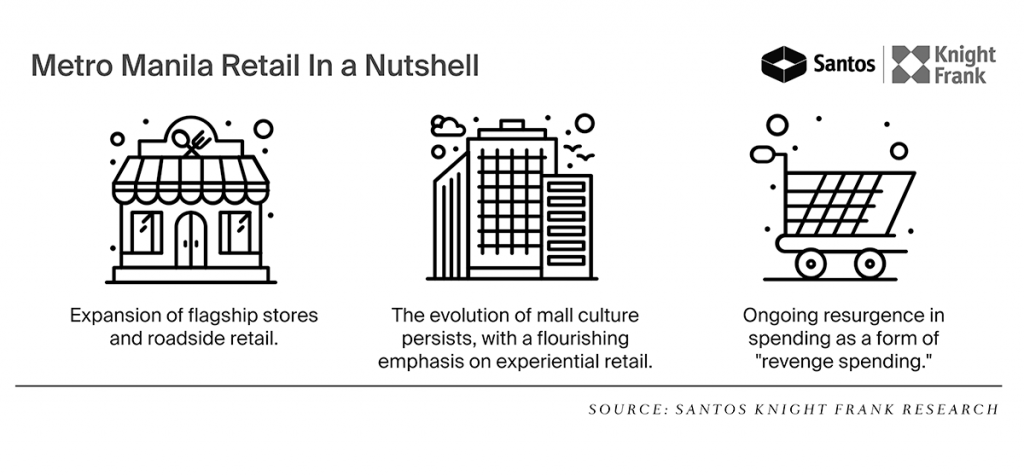The Philippine property market is seen to end the year on a positive note as both commercial and residential segments continue their post pandemic recovery, according to property service firm Santos Knight Frank (SKF).
“This growth is fueled by the ongoing expansion of outsourcing and leasing activities in the country, as global inflationary pressures and cost-cutting measures benefit the Philippine real estate market,” SKF said.
One of the growth drivers of the country’s real estate market is the office sector, which continued to show improving occupancy as of the third quarter of the year.
Data from SKF showed that Manila’s office occupancy rate is now at 80 percent after three quarters of consistent improvement from Q4 2022, when occupancy was at an all-time low of 75 percent.
Occupancy continued to be driven by the country’s top office districts Bonifacio Global City (BGC) and Makati with occupancy rates of 89 percent and 80 percent, respectively.
“The office market has continued its road to recovery post-COVID-19. The increased demand from conventional office tenants and flexible office operators has significantly contributed to the upswing in commercial leasing requirements. We are expecting this momentum to continue in 2024,” SKF chairman and CEO Rick Santos said.

As the global economy is in the post pandemic era, office markets are being shaped by the choice between in-office work and a flexible remote mode. SKF noted that there are signs that companies now are making long-term plans about their workplace setups.
Results of the Your Space 2023 survey by Knight Frank and Cresa showed that 87 percent of firms said they intend to have an office-centric model such as office-first, office-only, or hybrid over the next three years.
The said survey covered 350 international multi-market businesses covering 10 million employees globally.
When asked about the role of the office, respondents cited the physical workplace’s role in productivity, organizational culture, collaboration, and employee morale.
The survey further revealed the key amenities that occupiers understand their employees will be needing in the new office environment, with food and beverage offers ranking as the most preferred service/amenity with nearly 17 percent of responses. Occupiers also see the importance of facilities supporting mental wellbeing (14.4 percent) and gym facilities (12 percent).
In the Philippines, SKF noted that occupiers continue to prefer quality buildings that provide good value as prime buildings’ vacancy rate registered at 17 percent compared to the average office buildings’ vacancy of 20 percent.
This was despite prime lease rates averaging at P1,244 per square meter per month in the third quarter versus the market’s P980 per sqm per month lease rate.
SKF pointed out that Makati City emerged with the highest lease rate in the metropolis, with a weighted average lease rate of P1,143 per sqm per month.
Fort Bonifacio ranked second at P1,098 per sqm per month, followed by the Bay Area at P902 per sqm per month.
Aside from the office sector, the country’s residential market, particularly the luxury segment, is also seeing strong demand.
Data from the Knight Frank’s Prime Global Cities Index showed that Manila posted the fastest prime residential price growth in the world at 21.2 percent.
“Strong investor confidence in the Philippines during the current Ferdinand R Marcos Jr. administration has buoyed the real estate market despite rising interest rates,” Santos said.
“The luxury residential space is one of several sectors where we’re seeing encouraging market activity. Pent-up demand for prime properties, the return of the residential leasing market, and the tight supply of developments have contributed to significant price appreciation especially in central business districts,” he added.
SKF noted that the strong residential demand was also seen in the provincial condo market, driven by the increasing appetite for second homes.
The property services firm noted that the demand for second homes has been increasing since the pandemic, citing that 41 percent of respondents in a survey it conducted in 2021 said they were eyeing to buy a second home, a higher proportion than Asia Pacific.
“This trend is likely to continue in 2024, with local buyers acquiring leisure properties in Metro Luzon either for their end use or investment,” SKF said.
It shared that as of the third quarter of the year, 41 percent of condominium units sold in Luzon were leisure developments, particularly those located in tourist destinations such as Tagaytay, and Batangas.
“The remaining 59 percent of take up are traditional condominium units in urban areas in Luzon, an evidence of the growth of the vertical development market in cities in regions such as Cavite, Batangas, Laguna, and Pampanga,” SKF said.
Moreover, SKF shared that the country’s retail and logistics segments have seen a significant emergence of increased consumer spending driven by revenge spending.
“This trend in retail sales comes at the heels of the proliferation of flagship stores and roadside retail, with the likes of international brands (Gentle Monster, Skechers, Gucci, etc.), in areas such as Fort Bonifacio, Makati, and Quezon City,” SKF said.
Data from SKF showed that Metro Manila’s retail stock sits at 5.1 million sqm.
Taguig recorded the best-performing occupancy rate at 93 percent in the third quarter. in Q3.
In all, it’s looking good for property, another testament that the sector remains resilient.
